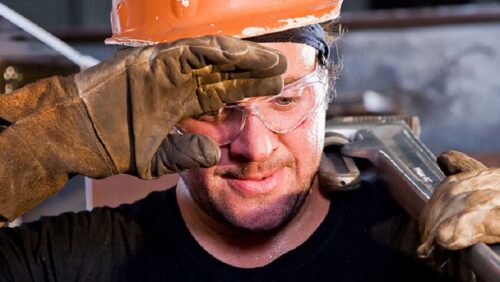
9.23.22 – ISHN
It’s paramount to know the exact temperature on your jobsite to protect workers in hot conditions. At higher temperatures, a change of even a few degrees can be a warning sign that you need to alter their workday activities to prevent the development of heat illnesses. To keep workers protected, you need a measurement tool that will calculate the most accurate temperature of your jobsite.
Comparing temperature measurements
Being aware of the weather forecast helps you know if you should expect any hazardous conditions like extreme heat. But a standard environmental thermometer can only track the local temperature and doesn’t take factors like humidity or wind into account. To get a more detailed calculation, agencies like NIOSH and OSHA recommend using the heat index to track environmental conditions. This measures relative humidity combined with air temperature to indicate what it feels like to be outside. However, this reading is measured in the shade and is only relevant for a general geographic area. Unless your group is lucky enough to spend most of their workday out of the sun, they may be working in an area that is far warmer than the heat index indicates.
Microclimates and how they influence local temperatures
Adding to concerns about general air temperature, any area of your jobsite may contain manufactured or natural elements that create what’s called a microclimate. Microclimates are weather conditions within a specific area that differ from the larger area around them. Neither the heat index nor an environmental thermometer will reliably provide an accurate measurement of a microclimate. Heat stressors like soil, bodies of water, trees, metal parts, machinery, cement, or asphalt can reflect or trap heat on your jobsite. This means that even if an environmental thermometer or the heat index says it’s 80⁰ F, your workers’ jobsite can feel much hotter and add more heat stress to their bodies. For maximum accuracy and safety, instead of a standard environmental thermometer or heat index, heat safety experts recommend using a Wet Bulb Globe Temperature (WBGT) monitor.
How does a WBGT work?
A WBGT monitor gathers up-to-the-minute heat stress readings to calculate the most accurate environmental temperature for an immediate area. By utilizing technologies such as a temperature sensor within a 1-inch black globe, the monitor gathers information in direct sunlight to track weather factors such as:
- Heat Index
- Relative Humidity
- Air & Dewpoint Temperature
- Barometric Pressure
- Solar Radiation
- Wind Direction & Speed
- Wind Chill
- Altitude
When environmental conditions reach a configured threshold, some monitors will even set off visual and audible alarms to alert nearby workers that they are working in a warning zone and they should adjust their work rate. Adjustments can be made by modifying work-to-rest ratios, taking additional hydration breaks, or adjusting their length of time in the heat, among other measures. You can determine heat stress warning zones when first configuring your monitor while inputting how heavy or light your team’s workload is, the heaviness or lightness of their PPE and clothing, and whether the jobsite is outdoors or indoors. Certain models allow for a vane mount installation that can track indoor wind sources such as a ceiling fan, too.
Understanding thermal work limits
In addition to various weather factors, some WBGT trackers can measure the Thermal Work Limit (TWL) of an area. TWL ratings are measurable limits for safe work determined by environmental conditions like relative humidity, wind speed, and ambient temperature. Though TWL ratings are not required by United States work agencies, many countries outside of the U.S. require them when tracking heat stress. So if your WBGT monitor can track TWL ratings, you can use guides available from the manufacturer as well as interventions for each zone to keep your workers safe.
Environmental monitoring as part of a comprehensive heat safety plan
Understanding the most accurate temperature of your jobsite is only one aspect of a comprehensive heat safety plan. The National Heat Safety Coalition, now the Heat Safety & Performance Coalition (HSPC), published a consensus document in 2021 after consulting with an interdisciplinary roundtable of world-renowned experts to create a go-to guide to help safety managers, employers, and industrial hygienists protect their workers from heat stress. In addition to environmental monitoring and ensuring that workers are hydrating throughout the day, the document outlines several recommendations, including:
- Providing heat safety education and training resources so workers understand risks and symptoms of heat illness
- Preparing workers’ bodies for the heat over the course of 5-7 days through the process of heat acclimatization
- Using health tracker devices or digital applications that monitor heart rate or body temperature
- Creating or designating a cooling area where workers can rest, cool, and hydrate away from the heat
- Preparing workers for emergency situations so they know what to do if they see a coworker exhibiting symptoms of heat illness
- Providing workers with body cooling PPE that will keep them cool for hours and can be easily reactivated throughout the day
A WBGT monitor is the latest technology to add to a modern industrial heat safety plan. Make sure you have all the pieces in place so you can create an all-encompassing protection plan for your workers.
John Heniff is a safety copywriter at Magid — proud U.S. manufacturer and distributor of head-to-toe PPE since 1946. For more information about Magid’s safety products and expertise, visit magidglove.com or call 800-444-8030.
